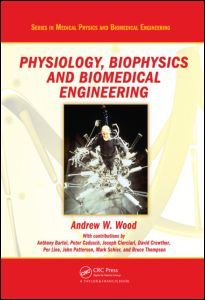Physiology, Biophysics, and Biomedical Engineering Series in Medical Physics and Biomedical Engineering Series
Coordonnateur : Wood Andrew

Physiology, Biophysics and Biomedical Engineering provides a multidisciplinary understanding of biological phenomena and the instrumentation for monitoring these phenomena. It covers the physical phenomena of electricity, pressure, and flow along with the adaptation of the physics of the phenomena to the special conditions and constraints of biological systems. While the text focuses on human biological systems, some of the principles also apply to plants, bacteria, and other animals.
The first section of the book presents a general introduction to physiological systems and describes specialized methods used to record electrical events from biological tissue. The next part examines molecules involved in cell transport and signaling as well as the proteins relevant in cells? ability to contract and generate tension. The text goes on to cover the properties of the heart, blood, and circulation and the monitoring of cardiac and circulatory function. It then discusses the importance of the interrelationship of pressures and flows in organ systems, such as the lungs and kidneys, and details the organization and function of the nervous system. After focusing on the systems used to monitor signals, the book explores modeling, biomechanics, and emerging technologies, including the progressive miniaturization of sensors and actuators in biomedical engineering.
Developed from the authors? courses in medical biophysics and biomedical instrumentation, this book shows how biophysics and biomedical engineering have advanced modern medicine. It brings together the physical principles underlying human physiological processes and the physical methods used to monitor these processes. Requiring only basic mathematical knowledge, the text supplements mathematical formulae with qualitative explanations and illustrations to encourage an intuitive grasp on the processes discussed.
INTRODUCTION: Introduction to Physiological Systems. Fundamentals of Electrical Circuits for Biomedicine. Properties of Electrodes. MAINLY MOLECULES: Molecular Biophysics. Membrane Biophysics. Excitability and Synapses. Skeletal Muscle Biophysics. HEART AND CIRCULATION: Cardiac Biophysics. Rheology of Blood. The Vascular System: Blood Flow Patterns in Various Parts of the Circulation. Cardiovascular System Monitoring. LUNGS, KIDNEYS, AND SPECIAL MONITORING: Respiratory Biophysics. Renal Biophysics and Dialysis. Cardiopulmonary Perfusion and Advanced Surgical Techniques. THE CENTRAL NERVOUS SYSTEM: Organization of the Human Central Nervous System. The Biophysics of Sensation—General. Vision. Audition and Vestibular Sense. Chemical Senses. SYSTEMS AND SIGNALS: Physiological Signal Processing. Bioelectrical Signals: The Electroencephalogram. Magnetic Stimulation and Biomagnetic Signals. Medical Imaging. Microscopy and Biophotonics. SYSTEMS INTEGRATION: Physiological Modeling. Biomechanics and Biomaterials. Biosensors and Emerging Technologies. Answers to Questions. Index.
Andrew W. Wood is a professor in the Brain and Psychological Sciences Research Center at Swinburne University of Technology. Dr. Wood was recently a member of the radiation health committee of the Australian Radiation Protection and Nuclear Safety Agency and the secretary and registrar of the Australian Radiation Protection Accreditation Board. His research interests include the health effects associated with nonionizing radiation, cellular neuroscience, fluorescence microscopy, and mathematical modeling.
Date de parution : 03-2012
Ouvrage de 750 p.
17.8x25.4 cm
Thèmes de Physiology, Biophysics, and Biomedical Engineering :
Mots-clés :
Round Window; Olfactory Receptor Cells; biomedical engineering; Spinal Cord; medical biophysics; Moving Window Average; human Physiology; Basilar Membrane; human biological systems; Ongoing EEG; cardiac monitoring; Vice Versa; biological tissue; Active Transport; molecules in cell transport and signaling; Mol ATP; circulatory monitoring; OLG; pressures and flows in organs; Laser Tweezers; central nervous system; Bode Plot; biomechanics; Nernst Potential; signal monitoring systems; Tr Ue; Biomedicine; Myosin Head; Physiological Signal Processing; Adh Secretion; Bioelectrical Signals; Hair Cells; Biophotonics; Olfactory Epithelium; Biomaterials; Fungiform Papillae; Biosensors; Taste Buds; Physiological Modeling; Half Cell Potential; biomedical instrumentation; Blood CSF Barrier; clinical monitoring systems; Virtual Cathode; medical imaging systems; Angiotensin Ii; White Cells



